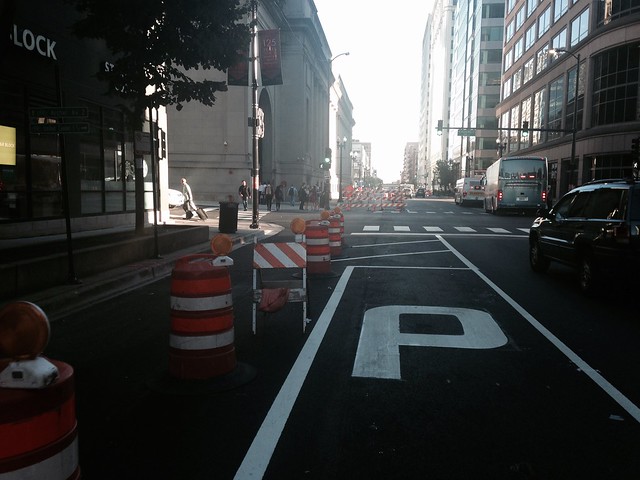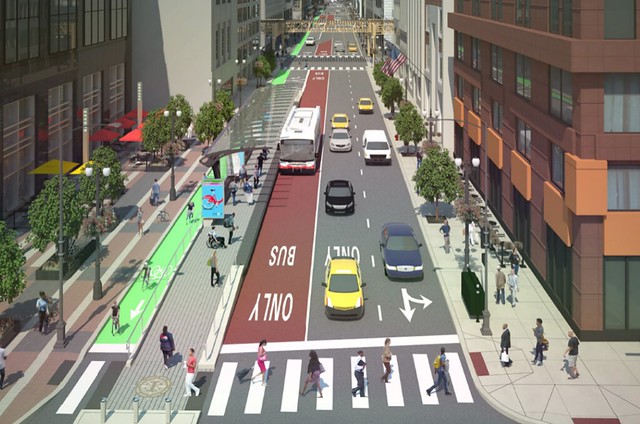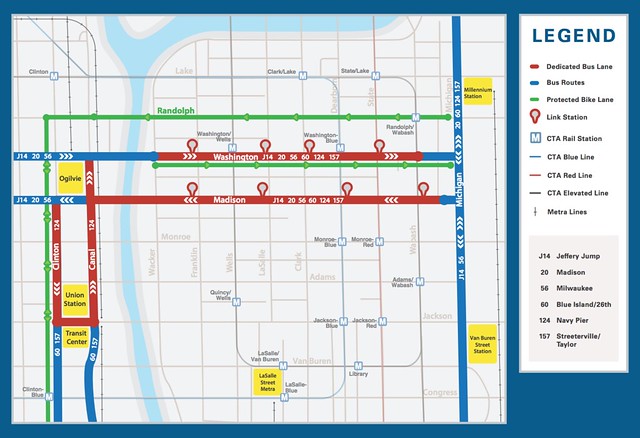
Last week’s update on the Loop Link bus rapid transit project by the Chicago Tribune’s Jon Hilkevitch raised some valid questions about the ultimate value of the project. Hilkevitch noted that some of the planned features of the downtown express bus corridor have been reduced, modified, or delayed. However, it looks like Loop Link will still be a major win for the central business district, which could pave the way for a more robust BRT route on Ashland Avenue.
Let’s look at some of the timesaving elements the Loop Link system won’t – and will – have. For starters, as originally planned, the route will have seven fewer stops than currently exist. Having stops roughly every other block, instead of every block, will definitely speed things up. The system will also feature dedicated bus lanes with red pavement. That should provide a significant traffic advantage for the six bus lines that will use the corridor, provided that there's decent enforcement to keep other vehicles out of the lanes.
Transit signal priority, which shortens red lights or extend greens to keep buses from getting stopped at intersections, isn’t planned for Loop Link. TSP already exists on part of the route for the Jeffery Jump, a South Side express bus that has a few BRT-style features. Because the downtown blocks are short and stoplights are closely spaced, providing TSP for one corridor might negatively affect intersecting or parallel streets, Chicago Department of Transportation spokesman Mike Claffey told Streetsblog.
However, there will be “queue jumps” for the BRT buses, which will give them a short head start before other vehicles get a green light, similar to leading pedestrian interval walk signals, Claffey said. “This will allow [the buses] to leave a station in advance of general traffic and avoid conflict with right-turning traffic on the next block."
CDOT is building eight Loop Link stations along Washington and Madison streets. The corridor, which also includes Canal and Clinton Streets, will link Union Station and the Ogilvie Center with Michigan Avenue. However, Hilkevitch reports, the planned station at Madison and Wabash Avenue won’t open until the spring, due to the construction of the new Washington-Wabash ‘L’ station, currently underway. That’s a little disappointing, but it won’t impact the ultimate performance of the BRT system.
Perhaps a more serious issue is that the Loop Link will lack prepaid boarding when it debuts. We’ve known for more than a year that the station at Madison and Dearborn Street would be the only stop with prepaid boarding to begin with, although the plan is to eventually expand the prepay system to all eight stations. However, Hilkevitch reports that even that pilot will be delayed until sometime next year.
“This will start after the service is launched to allow customers time to get used to the Loop Link corridor,” CDOT spokesman Claffey told Streetsblog. Again, it’s a bummer that this feature is being delayed, but hopefully the Madison/Dearborn pilot won’t launch too late in 2016, and we won’t have to wait too long until prepay is expanded to the whole system.
Another change to the plan is that the platforms of the island bus stations won’t be completely flush with all of the buses using the route. As late as last February, Loop Link materials promised that riders would be able to “get on or off the bus more quickly at bus-level stations that make it easy for everyone, including seniors and people using wheelchairs.”
While all of the Loop Link stops will have “near-level” boarding, since the CTA has an existing bus fleet that includes several models of buses, the design had to account for some variation between bus floor heights, Claffey said. “The platforms will be 11 inches high, which in some instances will be very close to level, and in all cases will be significantly closer to the bus floor.” While the bus driver may still need to employee a ramp for wheelchair users in some cases, the near-level platforms may eliminate the need to “kneel” bus to help seniors and people with disabilities who don’t use wheelchairs.

We’ve also known for almost a year that the bus shelter design has been downgraded. Earlier renderings, based on the winning entry of a station design contest, showed enclosed structures, but merchants were concerned that these would obstruct the view of their storefronts.
The shelters that are currently under construction are essentially 14-foot-tall canopies with a glass rear wall that stops several feet before the roof, so they'll offer limited protection from blowing rain and snow. However, the shelters will average 90 feet in length, long enough to accommodate two articulated buses. They'll also feature a bench that runs the length of the station, so just about everybody who wants to sit down will be able to.
To recap, we’re not getting transit signal priority, truly level boarding, and enclosed shelters, and the pilot of prepaid boarding will be delayed until next year. But we are getting limited stops, dedicated lanes, queue jumps, near-level boarding, and extra-long shelters with lots of seating, and we’ll eventually be getting prepaid boarding at all stations.

The remaining features should still make a significant improvement in bus times. The CTA has estimated that these improvements will make a westbound trip across the Loop 15 percent shorter, and an eastbound trip 25 percent shorter.
The proposed Ashland BRT project would have more features than the Loop Link, including center-running buses, prepaid boarding from level stations, buses with multiple doors, and transit signal priority. Last month, Mayor Rahm Emanuel announced the return of express bus service on Ashland and Western avenues, with the addition of TSP.
At the press conference, Emanuel seemed indicated that the full Ashland BRT project won’t move forward until the downtown corridor is completed. “The only BRT I’m investing in right now is the [Loop Link] in the Central Business District,” he said.
It looks like once the Loop Link system launches, and especially after prepaid boarding is established at all eight stations, Chicagoans will have a better idea of the benefits of BRT. Hopefully, that will help get the Ashland project moving again.






